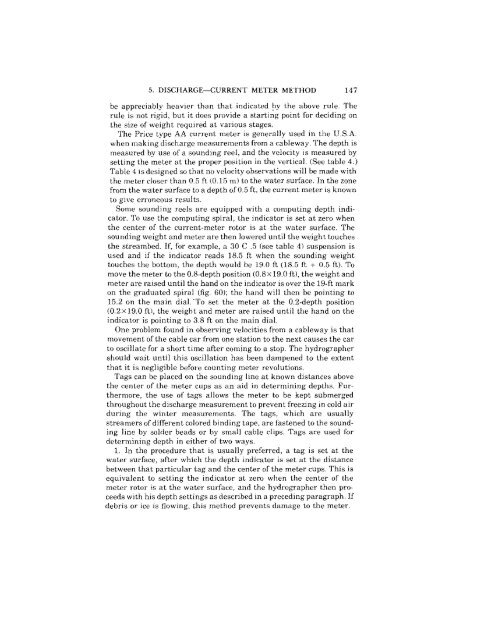PCWA-L 467.pdf - PCWA Middle Fork American River Project ...
PCWA-L 467.pdf - PCWA Middle Fork American River Project ...
PCWA-L 467.pdf - PCWA Middle Fork American River Project ...
You also want an ePaper? Increase the reach of your titles
YUMPU automatically turns print PDFs into web optimized ePapers that Google loves.
5. DISCHARGE-GURRENT METER METHOD 147<br />
be appreciably heavier than that indicated by the above rule. The<br />
rule is not rigid, but it does provide a starting point for deciding on<br />
the size of weight required at various stages.<br />
The Price type AA current meter is generally used in the U.S.A.<br />
when making discharge measurements from a cableway. The depth is<br />
measured by use of a sounding reel, and the velocity is measured by<br />
setting the meter at the proper position in the vertical. (See table 4.)<br />
Table 4 is designed so that no velocity observations will be made with<br />
the meter closer tban 0.5 ft \0.15 m) to the water surface. In the zone<br />
from the water surface to a depth of0.5 ft, the current meter is known<br />
to give erroneous results.<br />
Some sounding reels are equipped with a computing depth indicator.<br />
To use the computing spiral, the indicator is set at zero when<br />
the center of the current-meter fotor is at the water surface. The<br />
sounding weight and meter are then lowered until the weight touches<br />
the streambed. If, for example, a 30 C .5 (see table 4) suspension is<br />
used and if the indicator reads 18.5 ft when the sounding weight<br />
touches the bottom, the depth would be 19.0 ft (18.5 ft + 0.5 ft). To<br />
move the meter to the 0.8-depth position (0.8 X 19.0 ft), the weight and<br />
meter are raised until the hand on the indicator is over the 19-ft mark<br />
on the graduated spiral (fig. 60); the hand will then be pointing to<br />
15.2 on the main dial. 'To set the meter at the 0.2-depth position<br />
W.2x 19.0 fl.l, the weight and meter are raised until the hand on the<br />
indicator is pointing to 3.8 ft on the main dial.<br />
One problem found in observing velocities from a cableway is that<br />
movement of the cable car from one station to the next causes the car<br />
to oscillate for a short time after coming to a stop. The hydrographer<br />
should wait until this oscillation has been dampened to the extent<br />
that it is negligible before counting meter revolutions.<br />
Tags can be placed on the sounding line at known distances above<br />
the center of the meter cups as an aid in determining depths. Furthermore,<br />
the use of tags allows the meter to be kept submerged<br />
throughout the discharge measurement to prevent freezing in cold air<br />
during the winter measurements. The tags, which are usually<br />
streamers of diffel'ent colored binding tape, are fastened to the sounding<br />
line by solder beads or by small cable clips. Tags are used for<br />
determining depth in either of two ways.<br />
1. In the procedure that is usually preferred, a tag is set at the<br />
water surface, after which the depth indicator is set at the distance<br />
between that particular tag and the center of the meter cups. This is<br />
equivalent to setting the indicator at zero when the center of the<br />
meter rotor is at the water surface, and the hydrographer then proceeds<br />
with his depth settings as described in a preceding paragraph. If<br />
debris or ice is flowing, this method prevents damage to the meter,
















